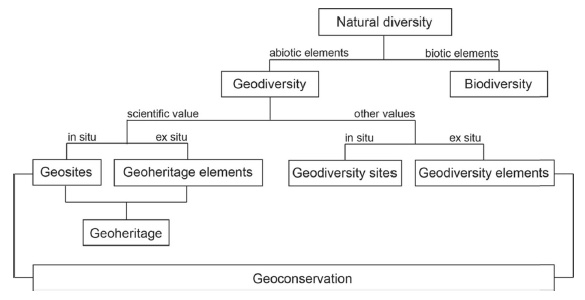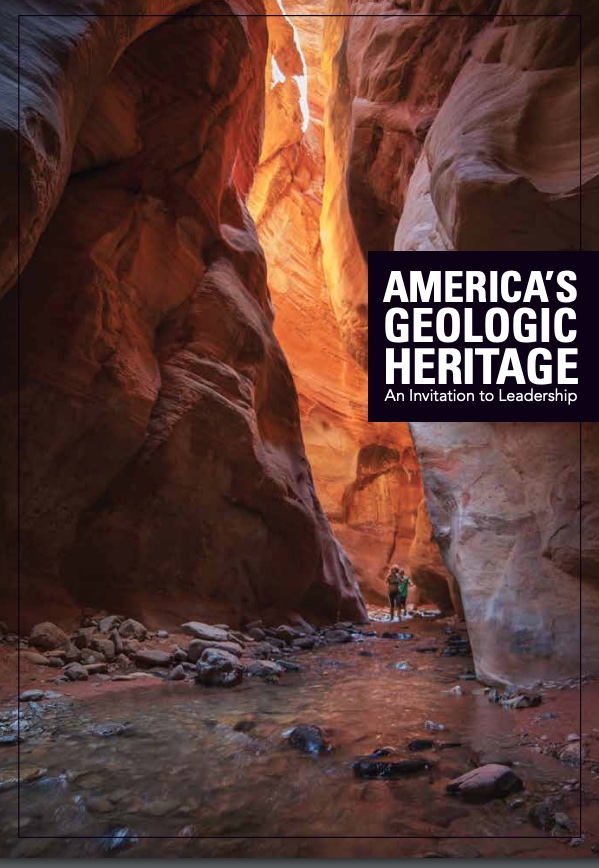The Stone Pavilion Project
Geoheritage
Geoheritage is an emerging field in the Earth Sciences. Important sources include:
-
The International Union of Geological Sciences Commission on Geoheritage
-
2017 Geological Society of America's Position Statement #20.
-
2021 report National Academy of Sciences's America's Geoheritage II
-
Current website for the National Park Service's America's Geoheritage Program
Geological Society of America
Position Paper #20 of the Geological society of America defines "Geoheritage" as a generic but descriptive term applied to sites or areas of geological features with significant scientific, educational, cultural, and/or aesthetic value." It recommends developing broad collaboration and partnerships between interested parties, which we have begun.
The GSA position paper differentiate three foci for site designation:
-
Scientifically and educationally significant geoheritage sites include those with textbook geologic features and landscapes, distinctive rock or mineral types, unique or unusual fossils, or other geologic characteristics that are significant to education and research.
-
Culturally significant geoheritage sites are places where geologic features or landscapes played a role in cultural or historical events.
-
Aesthetically significant geoheritage sites include landscapes that are visually appealing because of their geologic features or processes. Many geoheritage sites are tourist destinations that provide local and regional economic benefits.
UConn's Stone Pavilion broadly qualifies under all three headings:
-
It is Educationally significant owing to opportunity to be used as an interesting and captivating place that is publicly accessible at all times, has no admission fee, is fairly safe from harm, and contains an exhibit of stones from nationally important geoheritage sites. With a good website guide, and with trained teachers, it would be an ideal site for formal and informal educational programs at the college, K-12, preschool, and adult education.
-
It is Culturally significant because the construction and dedication of the pavilion coincided with the transition of UConn --as an exemplar of all Land Grant Colleges and Universities-- from their practical agricultural roots to their diversity of modern missions. During this time of rapid human transformation of the planet, agriculture is now being born again as regenerative agriculture. The stone pavilion, dedicated in 1937 to "America's Youth" as a "Tribute to Agriculture" occurred before the Great Acceleration beginning in the 1950s and industrial agriculture, can serve as a historic touchstone for the greater sense of stability. It is also culturally significant because the elements of the site --Local setting, state stones, regional materials, and national stones integrate and unify levels of societal organization that are being greatly strained by modern politics.
-
It is Aesthetically significant as a unique element of landscape architecture that was extremely well built. Together with its setting and collections, it can become a non-academic tourist site for UConn students, alumni, and visitors along with the Dairy Bar, Mirror Lake, and the Jonathan Husky Statue
NPS-AGI Collaboration
The National Park Service, which administrates the National Register of Historic Places, has a parallel, but informal register of geoheritage sites. They work with the American Geological Institute, a confederation of dozens of geoscience related organizations (created as an adjunct of the National Academy of Sciences) to produce the definitive guide to geoheritage in the United States.
Link to America's Geologic Heritage: An Invitation to LeadershipThe centerpiece of this report is a list of Five Big Ideas, each explored in depth.
-
America’s geologic landscape is an integral part of our nation's history and cultural identity, and we have a proud tradition of exploring and preserving our geologic heritage.
-
America’s geologic heritage, as shaped by geologic processes over billions of years, is diverse and extensive
-
America’s geologic heritage holds abundant values—aesthetic, artistic, cultural, ecological, economic, educational, recreational, and scientific—for all Americans
-
America’s geologic heritage benefits from established conservation methods developed around the world and within the United States; and
-
America’s geologic heritage engages many communities, and your involvement will ensure its conservation for future generations
Conservation of the Stone Pavilion as a geoheritage site or related feature embraces all of those values, beginning with the link between the geological landscape and its history and cultural identity. Regarding Point 1 above, the essay The Shape of Storrs reminds us that UConn owes its origin to the fertile lodgment till soils of the upland drumlinoid landscape that kept the Storrs family farm in business from 1698 to 1881.
National Park Service
The National Park Service is currently taking the lead at the national level on geoheritage nominations. Quoting their Geoheritage website: "Currently, there is no comprehensive national registry that includes all geoheritage sites in the United States. The list being developed here is meant to help strengthen the connections between geoheritage sites and encourage the sharing of best management practices nationwide."
Link to Current National Register of Geoheritage Sites.
Each state has a registry page for geoheritage sites. Connecticut's is one of the smallest, with only two sites listed in four categories:
-
-
Geoheritage Sites: There are no data listed.
-
Multi-Site Registry Links (page under construction. There are none)
-
Multi-site General Links: This includes (1) the NPS Geodiversity Atlas which names the Appalachian National Scenic Trail in CT, GA, MA, MD, ME, NC, NH, NJ, NY, PA, TN, VA, VT, AND WF. and (2) The NPS Geodiversity Atlas, currently listing only Weir Farm National Historic Site for Connecticut.
-
Related Links, namely the NPS Geodiversity Atlas - Index and the NPS Gelogical Resource Inventory, an excellent source of information.
-
International Union of Geological Sciences
For geologists, the UNESCO-funded International Union of Geological Sciences has a Commission on Geoheritage. Quoting their opening statement: "The commission on Geoheritage (IUGS-ICG) comprises 3 key areas that give recognition to IUGS Global Geosites, GeoCollections, and Heritage Stones of high international significance that have played an important role in the evolution of geological sciences."
The fact that the stones of the pavilion are ex situ, meaning moved from their original places, rather than in situ, or in place, diminishes their value as a "geosite" or "geoheritage" site, a designation usually reserved for natural outcrops or landforms of significance to the development of geology. So, for now, we will consider this a cultural site with geoheritage values.

In his framework, the stone pavilion, though partially in situ, is mainly an ex situ collection of stones of cultural and educational, rather than scientific value, and thus be considered a Geodiversity element.
Internationally, the most active and authoritative geoheritage organization is ProGEO, based in Europe.
Connecticut Historical Sites
The Connecticut State Department of Energy and Environmental Protection designates selected Historical Parks and sites as important to the state's environmental history. Three of these relate to geoheritage,
-
Old New-Gate Prison & Copper Mine, East Granby is "nationally recognized as the first chartered copper mine and first state prison in early America." The ore, tunnels, and prison built of waste rock are nationally significant
-
Beckley Furnace Industrial Monument, North Canaan. This structure signifies the importance of Connecticut's early iron industry, which vanished as technology and transportation improved.
-
The Henry Whitfield House and State Museum. Guilford, built of locally quarried granite, is "Connecticut's oldest house and New England's oldest stone house." Built in 1639 by English Puritans as a defensive building and private home, its early history signifies settler colonialism. It's later history signifies the "Colonial Revival era of the 1800s-1900s that celebrated and glorified European ethnocentricity and superiority."
The current plan for the Stone Pavilion Project is to seek out and apply for listings as warranted, pending permissions and write-ups.
